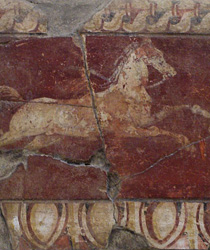 1
1The Greek Paradigm
The current visual evidence for Greek wall-painting as a direct antecedent falls into two categories. These are exemplified by domestic wall-paintings discovered on the Island of Delos and wall-paintings found in Macedonian tombs at Vergina and Lefkadia (figs.1-3). Many of the compositional features found at both of these sites suggest that early Roman pictorial techniques may have developed from sources such as these. Ancient literary references also support the view that a form of linear perspective was employed in Greek panel painting and scenography.
"Agatharcus, at the time when Eschylus taught at Athens the rules of tragic poetry, was the first who contrived scenery, upon which subject he left a treatise. This led Democritus and Anaxagoras, who wrote there on, to explain how the points of sight and distance ought to guide the lines, as in nature, to a centre ; so that by means of pictorial deception, the real appearances of buildings appear on the scene, which, painted on a flat vertical surface, seem, nevertheless, to advance and recede." (De Arch., Vitruvius, trans. Gwilt 1826:195)
The Macedonian tomb of Lyson and Kallikles at Lefkadia (3-2BC) is much debated as a precursor of Roman 'Second Style' painting. Whilst it shares certain common features regarding architectonic pictorial space, the wall-paintings in the tomb are significantly less sophisticated in their use of pictorial perspective deployed in a 3-dimensional space. Other tombs such as that attributed to Philip II of Macedonia also contain early examples of naturalistic figuration, but no substantial pictorial acknowledgment of the burial chamber itself. (For more on this subject see Miller, S.G., 1993, The Tomb of Lyson and Kallikles and Lehmann, P.W., 1979, “Lefkadia and the Second Style.” in Studies in Classical Art and Archaeology: A Tribute to Peter Heinrich von Blanckenhagen.)
The historical connections between Rome and Greece makes it almost certain that some form of artistic exchange took place, but even the few examples cited above indicate the problems associated with making direct correlations. Never-the-less numerous authors cite Pompeian wall-painting as if it was a direct copy of an earlier Greek painting.
A motif found in several Pompeian wall-paintings counters this view, it is that of the closed-door used in an eschatological or tragic context. As was pointed out earlier the Greeks did not normally bury or commemorate their dead by means of a tomb culture and hence they did not use the door motif in an eschatological context, unlike the Egyptians, Etruscans and the Romans. (Maiuri 1959:9 & Picard 1970:72) Hence, its appearance in several Pompeian paintings indicates that these are purely Roman compositions, which are not based on a symbolic language derived from the Greeks.
 1
1
|